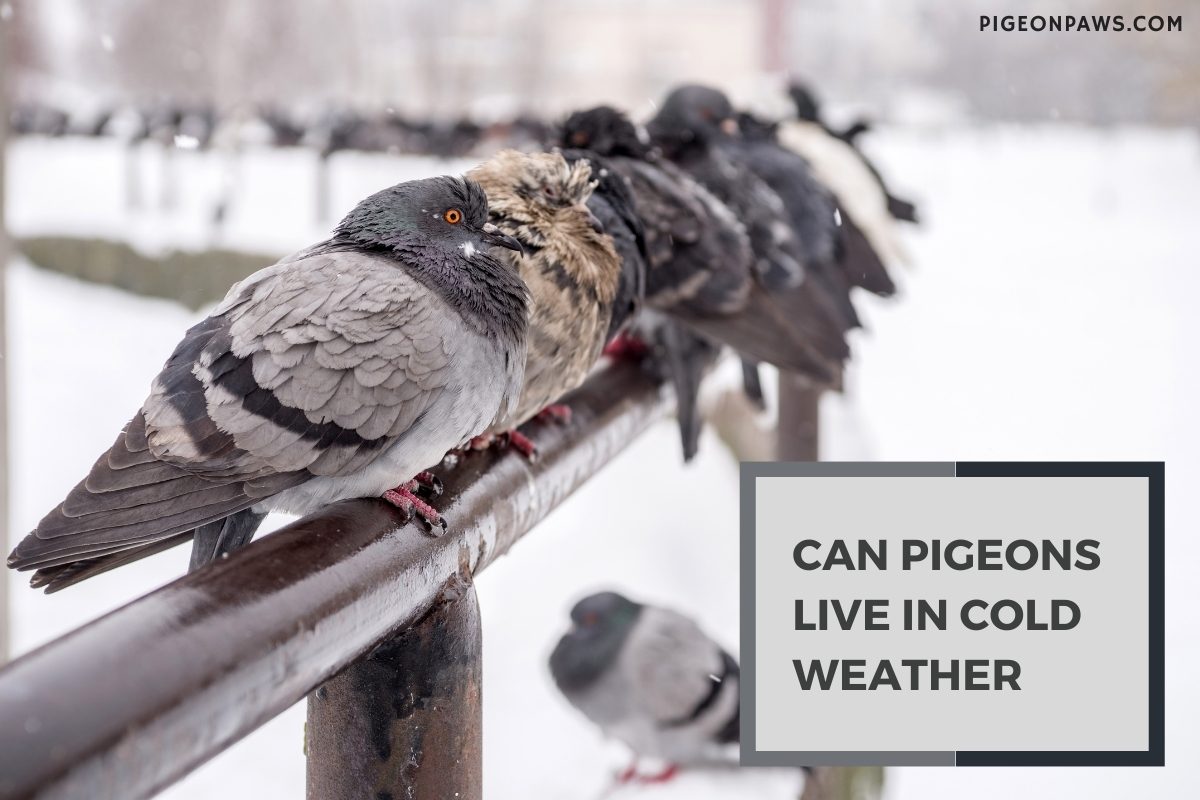Can Pigeons Live in Cold Weather? Winter Warriors!

Waking up to a cold winter morning with temperatures below zero. You bundle up in warm clothes to stay cozy, but what about the pigeons outside? Do they need to bundle up too? Can they even survive in such frigid temperatures?
Yes, pigeons can live in cold weather. They are hardy birds that can easily tolerate temperatures below freezing. While they may not enjoy the cold as much as warmer temperatures, they have adapted to living in various environments, including cities where snow and cold weather are common.
Now that you know pigeons can survive in cold weather let’s dive deeper into how they are able to do so and what steps you can take to ensure their safety and well-being during the winter months. So keep reading!

How Do Pigeons Adapt to Cold Weather?
Pigeons are hardy creatures and have adapted to various climates worldwide. During the winter months, they must adapt to survive the colder temperatures. Now, I will explore how they adapt to cold weather.
Feather Adaptation
In order to protect themselves from the cold, pigeons have thick feathered coats. Because of the close proximity of their feathers, warm air is trapped beneath a layer of their feathers. Moreover, at the base of their tails, they use an oil gland to coat their feathers, making them more water-resistant and insulating.
Roosting
During cold weather, pigeons will often roost in groups, huddling together to conserve warmth. Roosting together allows them to share body heat, which helps them stay warm during the night.
Metabolism
Pigeons have a high metabolic rate, which means that they can produce more body heat to stay warm. They also have a unique ability to slow down their metabolism during periods of food scarcity, allowing them to conserve energy and stay warm during the colder months.
Behavioral
In frigid conditions, pigeons exhibit a proclivity towards congregating in clusters to maintain body heat. Additionally, they display a tendency to take refuge in shielded enclaves, such as ledges, alcoves, and edifices.
In metropolitan settings, they may even ingress buildings or edifices to evade the piercing chill. Pigeons are also known to change their feeding habits during the colder months, consuming more high-fat foods to provide energy and maintain their body temperature.
What Precautions Can You Take to Protect Pigeons in Cold Weather?
If you’re a pigeon lover, there are a few things you can do to ensure your feathered friends stay safe and healthy during cold weather. Here are some precautions you can take:
Provide a Shelter
In order to stay warm and dry during the winter, pigeons require shelter. You can give them a basic birdhouse or a pigeon cage. Ensure that the shelter is well-insulated and shielded from the elements (wind, rain, snow).
Provide Food and Water
When it’s freezing outside, pigeons want a source of food and water. Keep their water source from freezing, and be sure to provide them with high-energy foods like grains, seeds, and nuts. You can give birds frequent access to fresh water or use a heated bird bath.
Avoid Feeding Too Much
While providing food during cold weather is important, be careful not to overfeed the pigeons. It can lead to health problems such as obesity and liver damage.
Check for Signs of Illness
Cold weather can weaken pigeons’ immune systems, making them more susceptible to illnesses. Keep an eye out for signs of illness, such as lethargy, loss of appetite, and difficulty breathing. If you notice any of these signs, consult a veterinarian.
Where Do Pigeons Go During Winter?
As winter approaches, they may need to make some changes to their behavior and habitat to survive the colder temperatures. Now, we will explore where pigeons go during winter and how they adapt to changing weather conditions.
Roosting sites
During winter, pigeons often gather in large flocks and roost together to conserve body heat. They may seek out sheltered areas such as building ledges, bridges, and other man-made structures to roost on.
These roosting sites provide protection from the wind and snow, and the close proximity of other pigeons helps to keep them warm.
Urban environments
Pigeons are well adapted to living in urban environments, especially during the winter months. The buildings and structures in cities provide a range of roosting sites, and there is often a constant supply of food available, thanks to the presence of humans.
Migration
Some pigeons may choose to migrate to warmer areas during the winter months. However, this is less common than in other bird species. Pigeons that do migrate may travel south to areas where the temperature is more tolerable or where food sources are more abundant.
Pigeon lofts
Pigeon keepers may choose to house their birds in a loft during the winter months. A pigeon loft is a specially designed structure that provides shelter and warmth for them. These lofts are typically equipped with heating systems and insulation to help maintain a comfortable temperature.
Pigeons Enjoying Snow During Winter
Conclusion
Pigeons are remarkably adaptable birds that can survive in a wide range of weather conditions, including cold winter weather. However, they still require some level of protection and care during the coldest months of the year.
By providing them with adequate shelter, food, and water, you can help ensure that these resilient creatures can weather the winter and continue to thrive.
So if you live in an area with cold winter weather, don’t be afraid to reach out to local bird experts or enthusiasts for advice on how to care for your feathered friends during the winter months. With a little effort, you can help these fascinating birds thrive in even the harshest of conditions.

